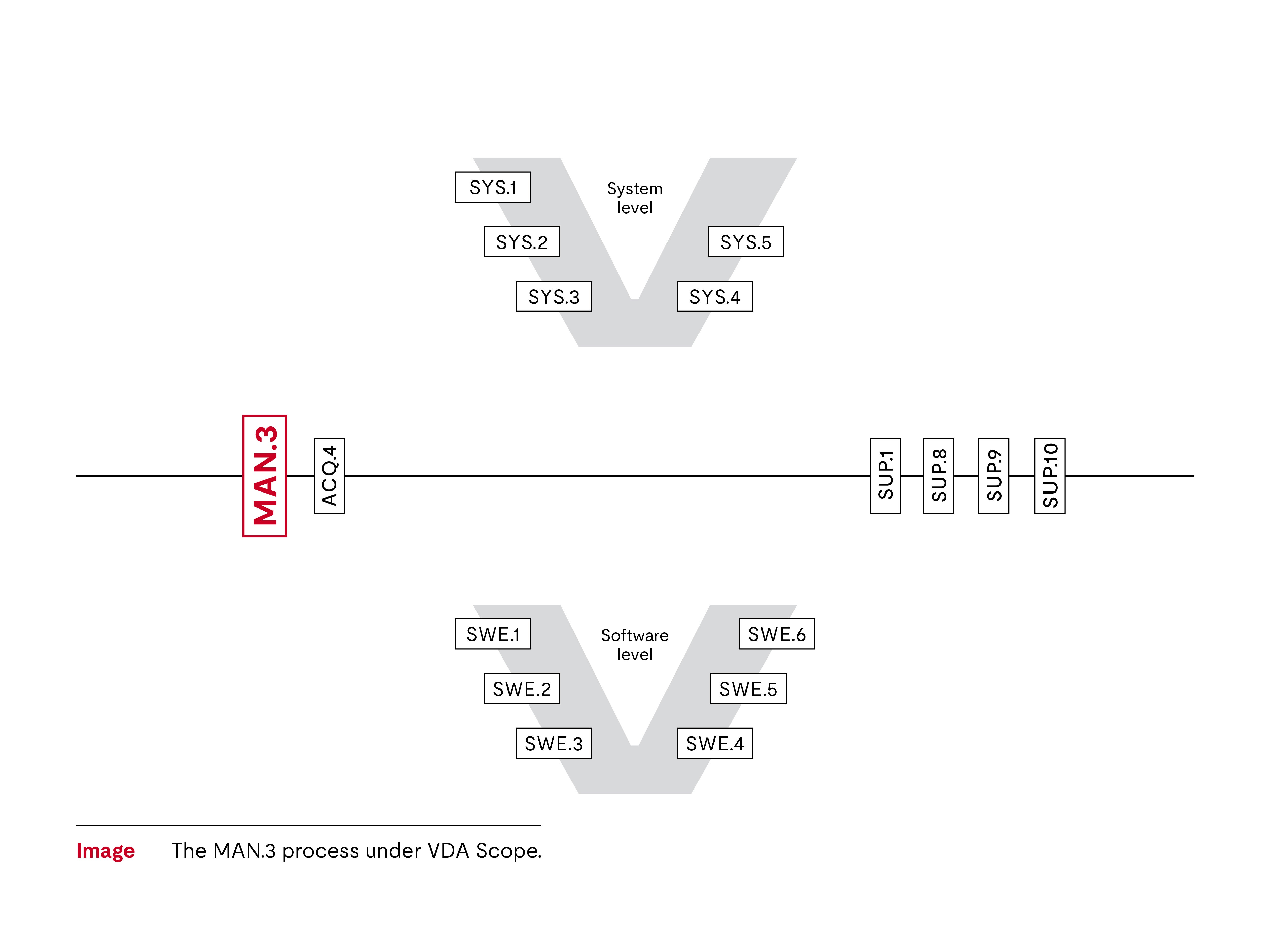

Process ID: MAN.3
Process group: Management
Automotive SPICE® is a trademark of VDA QMC.
Project management is a critical factor in the success of a project. Problems often arise in projects when:
- The project scope is not clearly defined.
- The effort required to complete a project is severely underestimated.
- There are numerous customer requests for new features but not enough staff capacity.
The Automotive SPICE® project management process (MAN.3) can help your organization identify, establish and control the activities and resources necessary for a project to produce a product.
Keep reading to learn about the three most important activities of project management in Automotive SPICE®.
The three most important activities of Automotive SPICE® MAN.3
1. Clearly define the project scope.
The project scope describes what the project is about and what it shall accomplish. Without a clear project scope, you don't have a basis to estimate your effort or justification for your personnel capacity. Projects that lack a clearly defined scope often have too much work for too few people, resulting in rushed, poor-quality work and staff frustration.
Here are several things to consider when defining a realistic project scope:
- Your inputs are the customer requirements and feature rollout plan. Check these documents for technical feasibility, realistic timing and whether you can build up staff quickly enough.
- Another input is your company’s development processes that indicate what internal work you need. A great source of information is similar past projects.
- Develop the project scope statement, which is a high-level definition of the product to be developed and the deliverables at each respective milestone.
- Develop the work breakdown structure (WBS), which describes everything that is delivered to the customer and all necessary internal project work.
2. Plan and monitor the work carefully
To help prevent investing considerable energy in planning and monitoring but not being effective and, at worst, losing control of the project, follow these simple rules:
- Do not plan distant periods of time in detail.
- Use rolling wave planning to plan the next development cycle in detail while planning distant cycles superficially.
- Regarding planning granularity, do not plan tasks with less than one day’s duration at the lowest planning level. Have an average duration of about one week.
Workflow management tools enable you to track work progress and compare hours worked to planned hours, which can help you identify tasks that do not go as planned. Use weekly technical meetings to discuss progress, issues, forecasts and outlooks.
3. Manage your stakeholders
Projects can fail simply because the right stakeholders are not involved. The people involved in a project help determine its success.
There are four key steps to stakeholder management:
- Identify potential stakeholders – Brainstorm with your team, or conduct interviews with stakeholders to identify additional stakeholders.
- Analyze the stakeholders – One method for analysis is the power/interest grid, which offers classifies stakeholders into four categories: high power/high interest, high power/low interest, low power/high interest, and low power/low interest.
- Plan how to engage stakeholders – Use a stakeholder engagement grid to plan how to bring a stakeholder from a current engagement level to a desired level.
- Manage and control stakeholder engagement – Communicate and work with stakeholders to bring their engagement to the desired level.
Why choose UL Solutions Software Intensive Systems for Automotive SPICE® support?
As part of our strategy to systematically improve development processes in the automotive electronics sector, UL Solutions Software Intensive Systems is an official licensee of Automotive SPICE®.
We can help automotive original equipment manufacturers (OEMs) and suppliers to achieve:
- Required capability levels within key development processes.
- Systematic improvement of existing workflows and methods.
- Clarity about the status of process improvements through formal assessments and gap analysis.
- Compliance with the requirements of Automotive SPICE® in harmony with security, functional safety and agile methods.
- Training of staff and assessors.
Learn more about the Automotive SPICE® project management process
Interested in deepening your understanding of the Automotive SPICE® project management process (MAN.3) from the Automotive SPICE® v4.0 Base Scope? Watch our video and read our complementary Automotive SPICE v4.0 Pocket Guide.
Read our related content
Automotive SPICE® Project Management (MAN.3) white paper
Services for Automotive SPICE and Extensions
Get connected with our team
Thanks for your interest in our products and services. Let's collect some information so we can connect you with the right person.
